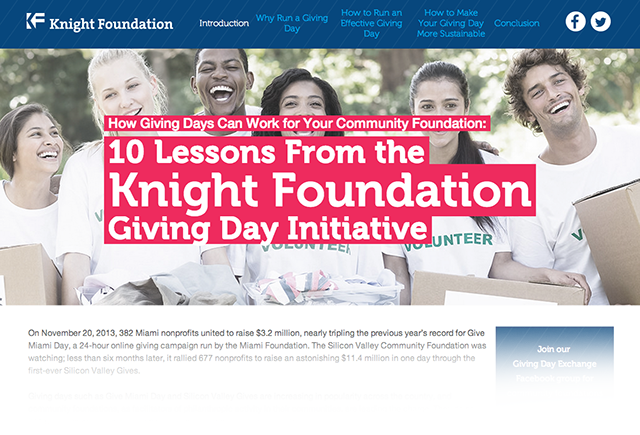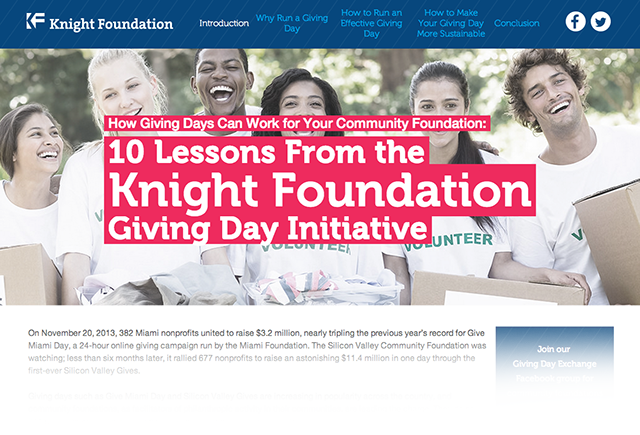
10 lessons for Giving Days, and one question: How can we make them more sustainable?
It’s impressive if you think about it: In just a few years, community foundations have learned to raise millions for local projects in 24-hour sprints. To do it, their Giving Day campaigns have embraced new technologies and outreach strategies to make philanthropy easy and, well, a ton of fun.

Related Links
“New Report Provides 10 Lessons for Foundations Planning Giving Days” – Press release
Giving Day Playbook web site
But now with a few Giving Days under their belts, we hear more and more community foundations asking how these campaigns fit into their long-term strategies. Certainly, they put philanthropy on people’s radar and raise money for great causes. A big win. But are they financially sustainable for the organizations that run them? How could these campaigns be organized to benefit both the community and the causes the foundation cares about?
With those questions in mind, Knight commissioned the consulting firm Third Plateau to evaluate the 18 Giving Days the foundation supports. The new report released today, How Giving Days Can Work for Your Community Foundation: 10 Lessons From the Knight Foundation Giving Day Initiative, can help organizers determine whether to run a Giving Day, how to run one effectively and how to make it more financially sustainable.
Certainly, some foundations are beginning to come up with their own answers to the sustainability question, in interesting and promising ways, for example by:
• Increasing funds under management: Seven community foundations for example used their Giving Days to open new or adding to existing endowment funds held by the community foundations, grow donor-advised funds, and/or raise money for the foundation’s own general programs and operations. In the long run, all of these will help increase operating dollars for the foundation.
• Cutting costs: Some stopped subsidizing donor processing fees – with no effect on nonprofit participation in the Giving Day (in fact their numbers increased.) The Blue Grass Community Foundation meanwhile levied a $500 participation fee for its challenge. The fee helped to strengthen nonprofits commitment to the Giving Day, as it has one of the highest rates of average donations raised per organization.
• Aligning with long-term goals: Some foundations used their campaigns as a way to raise awareness of issues they care about – that’s what the Community Foundation of Grand Forks and East Grand Forks Region did with Give Grand. That way the push helps promote an issue central to the foundation and community alike. A focused campaign brought awareness and resources from a diverse group of stakeholders in the community.
These are just some of many insights the report, at givingdayplaybook.org/10lessons, has for organizers and others thinking about this area of online fundraising. The report also goes in depth on ways foundations are succeeding at designing prizes, engaging donors and more.
To continue the conversation, we hope that community foundations will join our Giving Day Exchange group on Facebook, where you can swap insights with others who are also in the trenches. We also will take up the topic at a special deep dive session at the Council on Foundations’ fall conference in October.
The Giving Day debate comes at an interesting time for the field, as we all continue to think about the role of foundations in an age when the world continues to change rapidly around us. With the Web, the definition of community changes and expands constantly. The notion of the digital foundation is no longer a future aspiration, but a required practice for staying relevant. Crowdfunding and social giving changes the way we think about philanthropy and where resources come from in our communities. Standing still as the world evolves around us isn’t an option.
With Knight Foundation’s Giving Day Initiative, we are looking to help community foundations experiment with new technologies to reach out and engage the public, as we did when we published the Giving Day Playbook last year. While Giving Days have evolved substantially, foundations are still in experimentation mode. That’s a good thing for the growth and evolution of the field, and something we want to encourage. We hope this report can help those who see Giving Days as a part of their future.
Bahia Ramos is director/ community foundations at Knight Foundation.
Recent Content
-
Community Impactarticle ·
-
Community Impactarticle ·
-
Community Impactarticle ·


